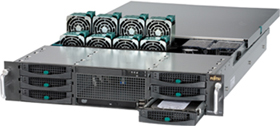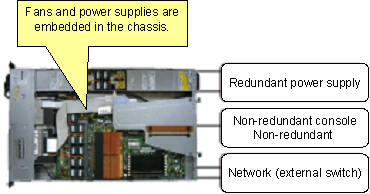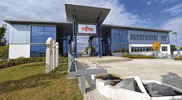-
IT Products and Systems
- Servers
- Storage
- Integrated Systems
- Client Computing Devices
- Peripheral Devices
- made4you
- Personal Computers Lineup
- Switches
- Mobile phones and Tablets
- OS End of Support
- Software
- Network
- Electronic Devices
- Other products
Archived content
NOTE: this is an archived page and the content is likely to be out of date.
PRIMERGY Feature Story - PRIMERGY RX300 S4 Features

A Dual Socket 2U Xeon based Rack Server, is designed to meet the objectives of an IT strategy aimed at reducing data center infrastructure costs. This is achieved by enhanced and clear system diagnostics that optimize management efficiency and allow you to maximize your investment.
Key Specifications
PRIMERGY RX300 S4 boasts the capacity of a fully-featured departmental server in a compact rack design only 2U in height.
Its breakthrough performance is achieved by a powerful design that incorporates leading-edge Quad-Core Intel® Xeon® X5460 (3.16GHz) /E5420 (2.50GHz)/E5405 (2GHz), and Dual-Core Intel® Xeon®X5260 (3.33GHz) /E5205(1.86GHz) CPUs.
Memory mirroring, by which one-half of the memory is set aside for redundancy, ensures continuity, with a maximum 48GB PC2-5300 ( DDR2-667) FB-DIMM memory installable, and with x8 DVD-ROM as standard.
The server can be expanded to cover nearly any workload: up to 1.8TB (300.0GB x 6) 3.5” SAS hard disk drives, and six free PCI slots for heavy I/O requirements.
Noise reduced

PRIMERGY RX300 S4 is also quieter than ever, with noise reduced a further 6dB from previous units. Its speed, power and versatility makes it ideally suited to the demands of business-critical environments, running data bases, terminal services and business applications, as well as consolidation and virtual machine tasks.
Rack server structure
Constant monitoring of environmental temperatures and main component heat output (CPU, PSU, etc.), enables the quieter PWM (Pulse-width modulated) fans to optimize their rotation frequency and reduction power consumption.

Strucuture comparison of Rack server and Blade server
| Rack sever *2 | Blade Server | |
|---|---|---|
| Manageability | Each server is equipped with power supplies, I/O and cables. Pulling rack servers from the rack and disconnecting the cables will require longer time to handle when the number of servers increases. | With all the features, including common modularity, cable-less power supplies and I/O and complete hot plug, blade systems take less time to maintain. |
| Power consumption | Power components are installed on each individual server. The more servers mean the more electrical power requirements. | Shared power supplies improve energy-efficiency for the entire system. When the number of blades is increased, electrical power use will increase just on a per blade basis. |
| Space requirements | An additional rack server needs additional 1U of space. (10 rack servers are deployed in 10U of space.) | Single chassis requires 7U of space. Up to 10 blades are installable in single chassis. |
| Add-ready | Each server needs to be installed separately and requires cabling process. | Initially, installing a chassis into a rack and cabling process are required. After the one-time investment, you can deploy up to 10 blades by simply inserting a blade in the chassis. |
| Operability | Each individual system may need to be managed separately, because server specifications vary depending on the time when you installed them. | Unified management hardware allows a collective operation even from a remote site. |
(*2) Based on comparison of server blades and 1U rack servers with equivalent specifications. These results do not apply to specifications of different rack servers. When consider which server form factor best suits your IT environment, please check each servers’ characteristics to ensure correct selection.






